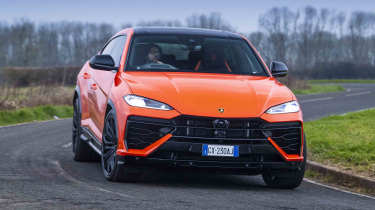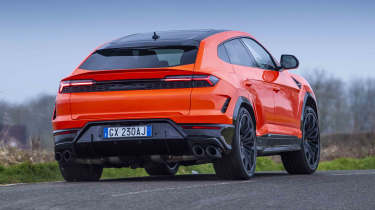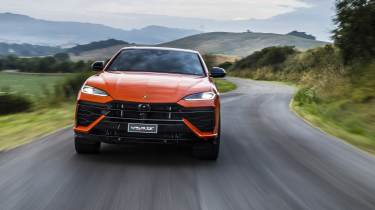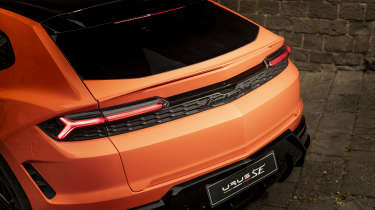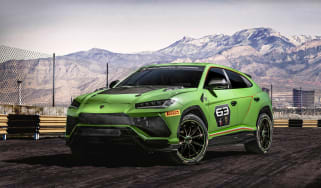Lamborghini Urus SE 2025 review – Sant'Agata's super SUV becomes a 789bhp hybrid
Lamborghini’s answer to the Aston Martin DBX has been given a major overhaul, going hybrid-only in the process. Has it become easier to like in the process?
The Lamborghini Urus is not the kind of performance car you’d normally find on evo’s wishlist, but there’s no denying its incredible success. A new breed of loyal owners have helped Sant'Agata replicate the ‘Cayenne effect’, exponentially raising sales and profits while carving out a following of its own. Last year, the Aston Martin DBX-rival received its most significant overhaul yet with the introduction of the Urus SE.
This new model presents a new chapter for the Urus, a mid-life facelift that hybridises the SUV – and indeed the whole Lamborghini range, which includes the Temerario and Revuelto – and is the core upon which a future Performante replacement will be based. Right now it’s the only Urus you can buy new, with the pre-facelift S and Performante versions being discontinued. In sales terms the SE has already hit the ground running, being sold out until 2026, but what’s it like to live with and drive?
Engine, gearbox and technical highlights
The Urus shares its platform with the Audi RS Q8 and Porsche Cayenne, and the SE’s combination of 4-litre twin-turbocharged V8, e-motor and 25.9kWh battery is also familiar from heavy-hitting VW Group cars like the Cayenne Turbo E-Hybrid and Bentley Continental GT. Lamborghini’s chief technical officer Rouven Mohr insists the firm never considered a downsized hybrid and that a chunky eight-cylinder heart is essential to the Urus experience. Different engine mounts to Bentley and Porsche are designed to preserve a bit of NVH to boost involvement. ‘We are not looking to eliminate every piece of feedback from the car,’ says Mohr. ‘It must retain an emotional connection.’
More reviews
Outputs are all slightly up on its cousins, a 612bhp tune of V8 pairing with a 189bhp motor for a 3.4sec sprint to 62mph, and 194mph top speed. The added weight of the hybrid powertrain is notable, mind, tipping the Urus past the 2.5-tonne mark for the first time. Lamborghini has seized an opportunity to overhaul the Urus’ dynamic character, the e-motor running through the eight-speed gearbox to have its power distributed via a central differential and rear e-LSD; the full combined totals of 789bhp and 700lb ft are spread variably fore and aft and then controlled laterally on the back axle. The car is always 4WD in regular use, though more extreme inputs can send every mite of power to the rear. ‘Hardware is still important, it’s the enabler to what you can now achieve with software,’ insists Mohr. ‘Companies that forget its importance will suffer.’
Suspension is by height-adjustable air springs with adaptive dampers, with active anti-roll bars and four-wheel steering to help disguise the SE’s considerable mass. The setup of the hardware changes depending on the drive mode – the left ‘tamburo’ trigger sequentially cycles through three tarmac and three off-road settings, while three buttons on the right of the gear selector provide access to performance, recharge and hybrid modes for the powertrain. Electric mode is accessed by pulling a dedicated switch.
Driver’s note
‘Driving a Urus silently around town in EV mode feels bizarre, and completely at odds with what is otherwise one of the most brash, look-at-me SUVs out there. But I like having the option to tone things down, and the engine is still the rumbling heart of the car when you wake it up.’ – Yousuf Ashraf, evo senior staff writer, who tested the Lamborghini Urus SE on the road in the UK.
Performance, ride and handling
Notch the car into Strada mode and the Urus works mostly as a hybrid, keener to involve the engine though at a refined and classy level. It will likely become your default for longer journeys. For shorter trips you can lean into the SE’s 37-mile range in EV mode, which can take you up to 84mph. In truth it feels wasteful to cruise at such speeds without the V8, which has always been core to the Urus experience.
Switch out of electric and into one of the more aggressive modes and the engine fires, filling the void immediately with a bassy growl. A bit like a (very) watered down version of a Le Mans Hypercar crawling out of the pits. Straight away there’s a sense of huge flexibility from the powertrain, the e-motor covering for the engine before the twin turbos hit their stride and providing instant response, without operating like a separate entity to the V8. Stretch it through the mid-range and the off beat V8 rumble turns into a slightly synthetic sounding blare, but you’re whipped along at such a rate you might not notice. It’s a fiercely accelerative SUV, never feeling as mighty as nearly 800bhp would suggest due to the weight, but more brutal than Porsche’s quickest Cayenne, which already melts your mind.
On the stonking 23-inch alloys of this test car, the ride is busy whatever drive mode you choose, though it gains compliance and a more confident stride on a motorway cruise. Pirelli has developed a bespoke P Zero compound across the range but says its character shifts in an upward sliding scale from comfort to commitment, and we suspect the softer focus of the 21s or 22s will be more welcome if this is an everyday proposition – as the Urus typically is for many of those loyal customers. As it stands the Urus is certainly livable, just not able to waft like a Range Rover Sport SV. It’s closer to the tighter, more connected feel of a GT Package-equipped Cayenne.
Pick up speed (which you do so very quickly) on a lumpy b-road and the chassis works hard to control that heavy body, the Urus jostling and fidgeting along and generally feeling quite aggressive. It feels big too, but the raft of chassis systems do sharpen the responses enough to not make it feel as extremely overweight as it is, merely very heavy. The steering is direct and firmly weighted, and the rear-wheel steering intervenes to usefully tighten your line in slower turns. Under hard acceleration and braking you do feel the mass pitching around – those active roll bars help mitigate lateral roll but longitudinal movements are resisted primarily by the springs and dampers.
It’s far from a deft, delicate car then, but the SE does have some impressive tricks up its sleeve when you find the right road – preferably a smoothly surfaced one with plenty of space to play with. The way it digs in, forces its mass to pivot into corners and rips from point to point is undeniably impressive. In Corsa mode the Urus is at its most neutral in the pursuit of track performance, but Sport brings out more fun and adjustability from the chassis. The 4WD system is reactive to your inputs, and learning the mindset of its software can yield cartoonish results. Under hard throttle the nose unloads and creeps wide, but stay committed with the steering cranked and the balance shifts the other way, the SE readily pitching into slides. It can be quite brutal when it moves around, the tyres straining and chirping under the stress of the cornering forces and all that weight, but it’s entertaining in an obscene kind of way.
The regen braking is adjustable to the driving mode, temperatures and battery charge level – but all via the car’s own brain rather than the driver’s fingers. Mostly, it all slips away into the background. Much like a Ferrari 296 GTB, it feels like the inevitable march to electrification has been woven into the car’s character as much as possible rather than reluctantly lumped on top. ‘You could do a purer internal combustion version but you’d lose a lot of the benefits,’ says Mohr. ‘Our new 4WD concept transforms the Urus. Put this car on Trofeo Rs and it’d be quicker than the old Performante.’
There are compromises – chiefly the extra weight that negates some of the SE’s power advantage and is perhaps responsible for the unsettled ride – but by and large, the SE has a broad repertoire, and fans of the outgoing model will find plenty to like.
Driver’s note
‘In Sport, it doesn’t take much provocation for the rear axle to play a lead role out of roundabouts and tighter corners. Nothing too antisocial, just a giddy, up on its toes sensation that – given the space to play – will goad you on to drive harder to unlock more of its dynamism. Four-wheel steering and active anti-roll bars do their bit to chip away at the sensation of mass and its c300kg climb over the old Urus S does metaphorically shrink, at least a little.’ – Stephen Dobie, evo contributor, who tested the Lamborghini Urus SE on the launch in Italy.
MPG and running costs
The Urus’s battery only charges at 7kW (a dieting measure, apparently) and the engineers are keen to point out its ability to recharge at up to 80 per cent on the move, something they reckon lots of customers will exploit as low-emission cities become more prevalent. Fully topped up, the WLTP claims are 135.8mpg and 51g/km of CO2, while a discharged battery sees official fuel economy tumble to 21.9mpg. Of course you’ll use no fuel at all when running in electric mode, with 37 miles possible at speeds of up to 84mph.
In reality, we saw mid-20s on extended motorway drives while short on battery power, creeping closer to 30mpg on a long journey from a full charge. Far from Lamborghini's claim but not bad for a near-800bhp, 2.5-ton car. To get the best efficiency from the Urus you need to top the battery up at a charging station, rather than using the engine. On long trips, having enough battery power for when you want it – when the road and conditions allow you to use all the performance, for example – means keeping an eye on your state-of-charge and using the recharge mode where needed. True of most plug-in hybrids, but something you don’t need to think about in a pure petrol SUV.
Design, interior and tech
The SE’s cabin will be familiar to previous Urus owners, with a near vertical slab of dashboard ahead dressed with typical Lambo cues, such as angular trim, trapezoidal air vents and in our test car, a mix of orange leather accents and carbonfibre. The fundamental layout (and some of the switchgear) is borrowed from the Audi RS Q8, which comes as no surprise given the two share a platform. But the design is different enough to make the Urus feel like a unique, more special product.
The overall look might be similar to before but the SE has been given a smattering of updates, including a new 12.3-inch central infotainment display with newer software (which appears to be based on Audi’s system with bespoke graphics), as well as new trim on the seats and dashboard. As before there’s a separate lower touchscreen for the climate controls and a fully digital dash, and a fair share of ergonomic quirks.
The bank of airplane-style selectors on the centre console look cool but are confusing to use. The central gear selector is only used to engage reverse, for example, with park and manual mode being activated by separate buttons, and drive being engaged by pulling the right hand paddle on the wheel. Just one lever would do.
Then there’s the drive mode selector, which is a pull switch that runs through six modes but doesn’t allow you to select a previous one without cycling through them all again – a pain if you want to quickly nip from Sport back to Strada. Form has walloped function here. The chintzy red flap over the starter button is still a fun novelty, though, a mainstay since the launch of the Aventador.
Price and rivals
Just like some of its rivals the Lamborghini Urus SE is sold out for a while, but if you can get your hands on one you’ll pay from £208,000. This figure makes the new Urus significantly less expensive than the Ferrari Purosangue, but its pure-combustion V12 powertrain will always have a draw that nothing else can match.
Step from Italy to the United Kingdom and you’ll find that the new Urus is a near-exact match for the new Aston Martin DBX S in terms of price. We haven’t driven it yet but if the DBX707 is anything to go by, it’ll offer a compelling mix of speed, dynamics and GT-like cruising ability. Like the Ferrari, this too goes without hybrid assistance, its pure-combustion V8 churning out 717bhp.
The likes of the Range Rover Sport SV and Mercedes-AMG G63 will save you some cash at £139,995 and £189,375 respectively, but Porsche’s Cayenne Coupe Turbo E-Hybrid is the driver’s choice of the bunch when equipped with the GT Package, sharing hardware with the Urus but at a lower £166,100 asking price.
Lamborghini Urus SE specs
| Engine | V8, 3996cc, turbocharged, plus single e-motor |
| Power | 789bhp |
| Torque | 700lb ft |
| Weight | 2505kg |
| Tyres | Pirelli P Zero (bespoke compound, 285/35 23 front, 325/30 23 as tested) |
| Power-to-weight | 320bhp/ton |
| 0-62mph | 3.4sec |
| Top speed | 194mph |
| Price | £208,000 |
